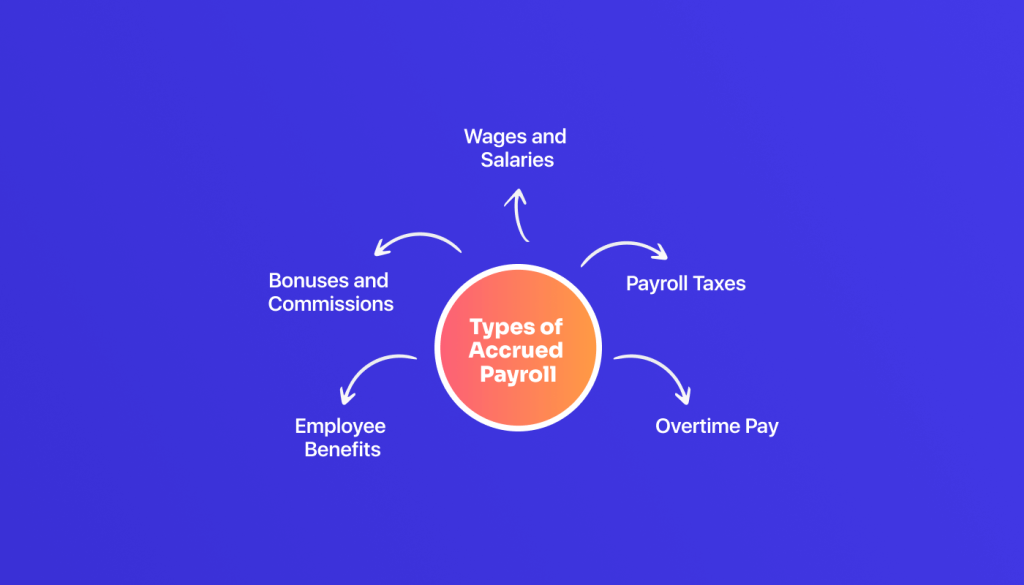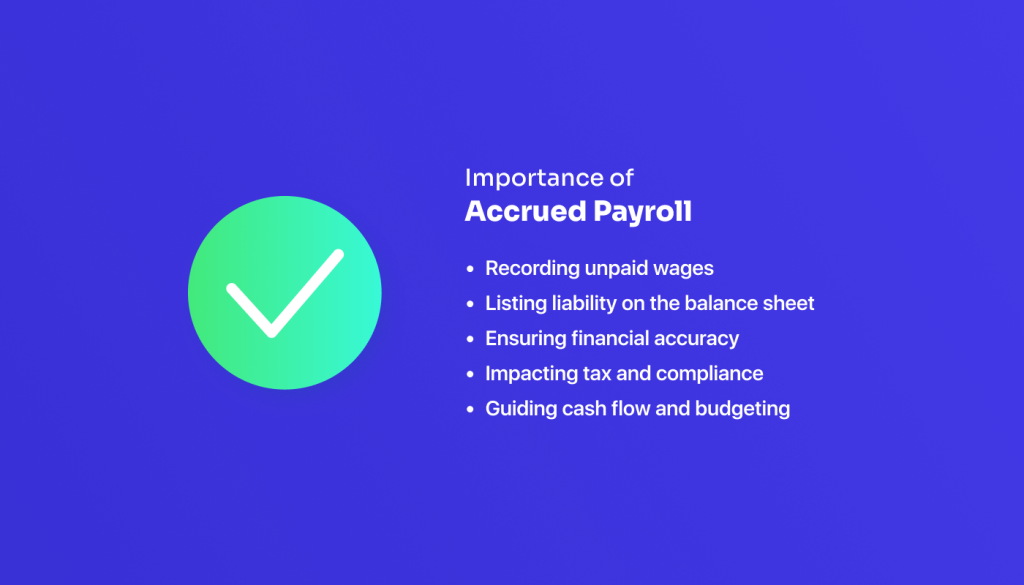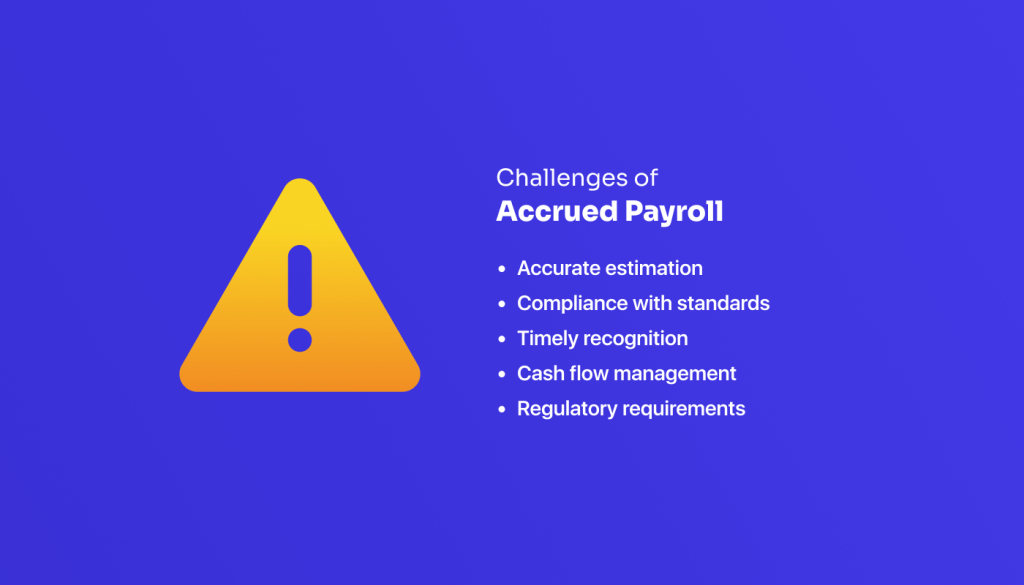Accrued payroll is a fundamental concept in HR management. It includes things like salaries, wages, bonuses, and benefits. Managing the accrued payroll process ensures that everyone gets paid for their time. Besides, it’s essential for accurate financial reporting and compliance with labor laws and regulations.
In this blog post, we’ll discuss what accrued payroll is, its types, calculation process, associated challenges, considerations, and more!
What is Accrued Payroll
Accrued payroll is the money you’ve earned but haven’t received yet. It’s what your employer owes you for the work you’ve done!
It also defines the company’s payroll liabilities. Or, the outstanding amount they need to settle with their employees.
Essentially, accrued payroll ensures employees get paid for their time and effort even if the actual disbursement occurs at a later date.
Types of Accrued Payroll

Employees earn different types of compensation, and accrued payroll can be varied according to these categories. Here are the 5 major types of accrued payroll:
1️⃣ Wages and Salaries
Wages and salaries include the regular pay that employees receive for their work hours. It’s what they get paid regularly, like every week or month.
For example, if someone works 40 hours a week and earns $15 for each hour, they’ll make $600 for that week, $2,400 in a month.
2️⃣ Bonuses and Commissions
Bonuses and commissions are the additional compensation provided to employees based on performance, sales targets, or other criteria. A salesperson might receive a bonus for exceeding their sales targets for the month. The Fair Labor Standards Act (FLSA) regulates bonuses and commissions policies in organizations.
3️⃣ Overtime Pay
Compensation for hours worked beyond the standard workweek or workday is considered as overtime pay. This is typically paid at a higher rate than regular wages.
In the US, if non-exempt employees work more than 40 hours in a week, they get paid 1.5 times their normal pay for those extra hours. FLSA also ensures companies are included in the calculation of overtime pay for non-exempt employees.
4️⃣ Payroll Taxes
Various taxes that employers are required to withhold from employee wages. This includes federal/state income tax, Social Security tax, and Medicare tax.
For example, an employee earns $1,000 in gross wages and the federal income tax withholding rate is 10%. The employer would withhold $100 from the employee’s paycheck for federal income tax.
5️⃣ Employee Benefits
Employee Benefits are non-wage compensations provided to employees in addition to their regular pay. These can include contributions towards health insurance, retirement plans such as 401(k) contributions, paid time off (vacation, sick leave), and other benefits offered by the employer.
The Employee Retirement Income Security Act (ERISA) governs employee benefits, including retirement plans in the United States.
How to Calculate Accrued Payroll
Calculating accrued payroll is a structured task for any business. In this section, we’ll show the steps of calculating accrued payroll effectively.
Determine the Pay Period
Identify the time period for which you need to calculate accrued payroll. This could be a weekly, bi-weekly, semi-monthly, or monthly period.
Calculate Employee Wages and Salaries
Determine the total wages and salaries earned by each employee during the pay period. This includes regular hours worked as well as any overtime hours.
Calculate additional Earnings
If applicable, calculate any other extra earnings such as bonuses or commissions that employees have earned during the pay period.
Calculate Payroll Taxes
Next, calculate the payroll taxes owed by both the employer and the employee for the pay period. This includes federal income tax, state income tax, Medicare tax, Social Security tax, etc.
Helpful ➡️ How Payroll Software Helps With Tax Calculations
Calculate Employee Benefits
Measure the value of any employee benefits earned during the pay period. It can be health insurance premiums, retirement contributions, etc.
Total Accrued Payroll
Add up the total wages, bonuses, commissions, payroll taxes, and employee benefits to get the accrued payroll for the pay period.
Record Accrued Payroll
Finally, record the accrued payroll as a liability on your company’s balance sheet for transparent and accurate payroll processing.
Note: It’s important to note that accrued payroll calculations may vary depending on factors such as employee classification (e.g., hourly vs. salaried), overtime policies, and specific benefit offerings. Additionally, compliance with local labor laws and accounting standards should be considered when calculating accrued payroll.
Examples of Accrued Payroll Calculations
Accrued payroll calculations can be different according to employee types, working hours, and associated other factors.
To make the calculation accrued payroll process clearer, here are 5 quick examples.
Hourly Employee Calculation
Scenario:
- Hourly Rate: $15 per hour
- Hours Worked: 40 hours
- Overtime Hours: 5 hours (overtime rate is 1.5 times regular rate)
Calculation:
✔ Regular Wages = Hourly Rate * Hours Worked = $15 * 40 = $600
✔ Overtime Wages = Overtime Rate * Overtime Hours = $15 * 1.5 * 5 = $112.50
✔ Total Accrued Payroll = Regular Wages + Overtime Wages = $600 + $112.50 = $712.50
Salaried Employee Calculation
Scenario:
- Annual salary: $60,000
- Number of pay periods per year: 26 (bi-weekly pay)
Calculation:
✔ Accrued payroll per pay period = $60,000 / 26 = $2,307.69
Commission-Based Employee Calculation
Scenario:
- Base salary: $30,000
- Commission rate: 5%
- Total sales for the pay period: $20,000
Calculation:
✔ Commission earned = 5% * $20,000 = $1,000
✔ Accrued payroll = Base salary + Commission earned = $30,000 + $1,000 = $31,000
Bonuses and Overtime Calculation
Scenario:
- Hourly rate: $25
- Hours worked in the current pay period: 45 hours
- Overtime rate: 1.5 times the regular hourly rate
- Bonus amount: $500
Calculation:
✔ Regular pay = $25/hour * 40 hours = $1,000
✔ Overtime pay = ($25/hour * 1.5) * (45 hours – 40 hours) = $187.50
✔ Total accrued payroll = Regular pay + Overtime pay + Bonus = $1,000 + $187.50 + $500 = $1,687.50
Accrual of Unused Paid Time Off (PTO)
Scenario:
- Employee’s hourly rate: $20
- Accrued PTO hours per pay period: 5 hours
Calculation:
✔ Accrued PTO pay = $20/hour * 5 hours = $100
How to Record Accrued Payroll and Taxes
To record accrued payroll and taxes, businesses must first recognize the earned wages of employees as a liability on their financial records. This process includes accruing the unpaid wages of the employees for their performed work in the balance sheets.
Similarly, taxes owed on this accrued payroll must also be recognized, even if they haven’t been disbursed. The process typically involves debiting the wages expense and payroll tax expense accounts. Plus, crediting accrued liabilities for payroll and accrued taxes payable accounts respectively.
In addition, it’s crucial to ensure accuracy in recording these entries by reconciling them with payroll reports. Overall, accurate recording helps to maintain financial integrity and compliance with accounting standards.
Importance of Accrued Payroll in Financial Reporting

Consistent and precise financial statement reporting is essential for the success of any business operation. Accrued payroll ensures the accuracy and transparency of a company’s financial documentation
Here is the importance of accrued payroll for preparing your company’s financial reporting:
Recording Unpaid Wages
Accrued payroll helps in accurately reflecting a company’s financial obligations. It ensures transparency and reliability in financial reporting.
Listing Liability on the Balance Sheet
Listing unpaid wages on the balance sheet provides stakeholders with a clear understanding of the company’s financial health and liabilities.
Ensuring Financial Accuracy
Accurate financial reporting facilitates tax compliance. As a result, it helps in reducing the risk of penalties or audits from tax authorities.
Impacting Tax and Compliance
It aids in cash flow management and budgeting by allowing businesses to plan for upcoming payroll expenses, ensuring sufficient funds are available.
Guiding Cash Flow and Budgeting
Properly recording accrued payroll ensures financial accuracy. Also, enables informed decision-making and effective resource allocation within the organization.
Challenges and Considerations

In this section, we’ll explore the challenges and considerations. Also, propose solutions to help businesses effectively manage accrued payroll.
Accurate estimation
Accurately estimating accrued payroll can be difficult due to fluctuations in employee hours and compensation structures.
💡Solution: Implementing robust payroll software systems for tracking employee hours and regular reviews can improve estimation accuracy.
Compliance with standards
Ensuring compliance with accounting standards and regulations when recording accrued payroll poses a challenge.
💡Solution: Staying updated with relevant accounting standards and seeking professional guidance can ensure compliance.
Timely recognition
Timely recognition of accrued payroll may be hampered by delays in recording or processing payroll data.
💡Solution: Implementing efficient payroll processing software systems and establishing clear timelines for recognition can address this challenge.
Cash flow management
Managing cash flow effectively while accounting for accrued payroll obligations can be complex.
💡Solution: Developing comprehensive cash flow projections and setting aside funds specifically for payroll can aid in cash flow management.
Regulatory requirements
Meeting regulatory requirements regarding the recording and reporting of accrued payroll adds complexity.
💡Solution: Regularly reviewing regulatory updates and engaging with legal or accounting experts can help ensure compliance with requirements.
Learn more ➡️ 10 Common Challenges in Payroll Management
FAQs
Why is understanding accrued payroll beneficial?
Understanding accrued payroll is beneficial as it enables businesses to accurately reflect their financial obligations, ensuring transparency in financial reporting. It also helps in effective cash flow management for upcoming payroll expenses.
What do accrued salaries mean?
Accrued salaries mean wages that employees have earned but haven’t been paid yet by the employer. They represent an obligation for the employer to pay the employees in the future.
Is accrued payroll an asset?
No, accrued payroll is not considered an asset. Instead, it is recorded as a liability on the balance sheet. Because it represents an obligation for the company to pay employees in the future for work already performed.
Wrapping it up…
Understanding accrued payroll helps businesses maintain financial transparency, comply with accounting standards, and effectively manage cash flow.
Here we’ve discussed what is accrued payroll, its categories, calculation process, challenges, and the ways to overcome them.
By addressing these aspects of accrued payroll, hopefully, your businesses can ensure financial stability and openness in their operations.



Leave a Reply